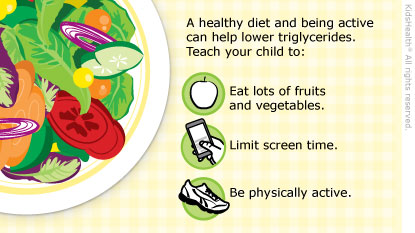High Triglycerides: How to Care for Your Child
Testing shows that your child has high triglycerides (try-GLIS-er-ides). Triglycerides are a type of fat that comes from foods like butter, oils, and other fats you eat. Having high triglycerides during childhood may increase the risk of heart problems and stroke when the child is an adult.
For most kids, eating a healthy diet and being physically active can help lower triglycerides. If your child is overweight, losing weight also will help. Always talk to your health care provider before putting your child on a diet.


-
Serve healthy foods:
-
Avoid foods and drinks that are high in sugar, and limit refined grains (such as white flour, white bread, and white rice).
-
Choose fiber-rich foods, including whole grains (such as whole wheat flour), fruits, and vegetables.
-
Include foods with omega-3 fatty acids, which are found in fatty fish (like salmon), walnuts, flax seeds, and olive oil.
-
Help your child stay at a healthy weight:
-
Give your child 5 or more servings of fruits and vegetables every day.
-
Limit your child's non-school screen time (TV, computer, tablet, phone, and video games).
-
Make sure your child gets 1 hour or more of moderate to very active exercise every day.
-
If your child is overweight, follow the weight-loss plan your health care provider recommended.
-
Give your child any prescribed medicines as directed.
-
Schedule the recommended follow-up visits. The health care provider will want to check your child's triglycerides level again after you've followed these instructions for a while.


What can happen if my child has very high triglycerides? Very high triglycerides can cause inflammation (swelling and irritation) of the pancreas, a condition called pancreatitis. The pancreas is an organ in the abdomen that helps digest food and control blood sugar.
Are there other causes of high triglyceride levels? Yes, other causes of high triglycerides include: